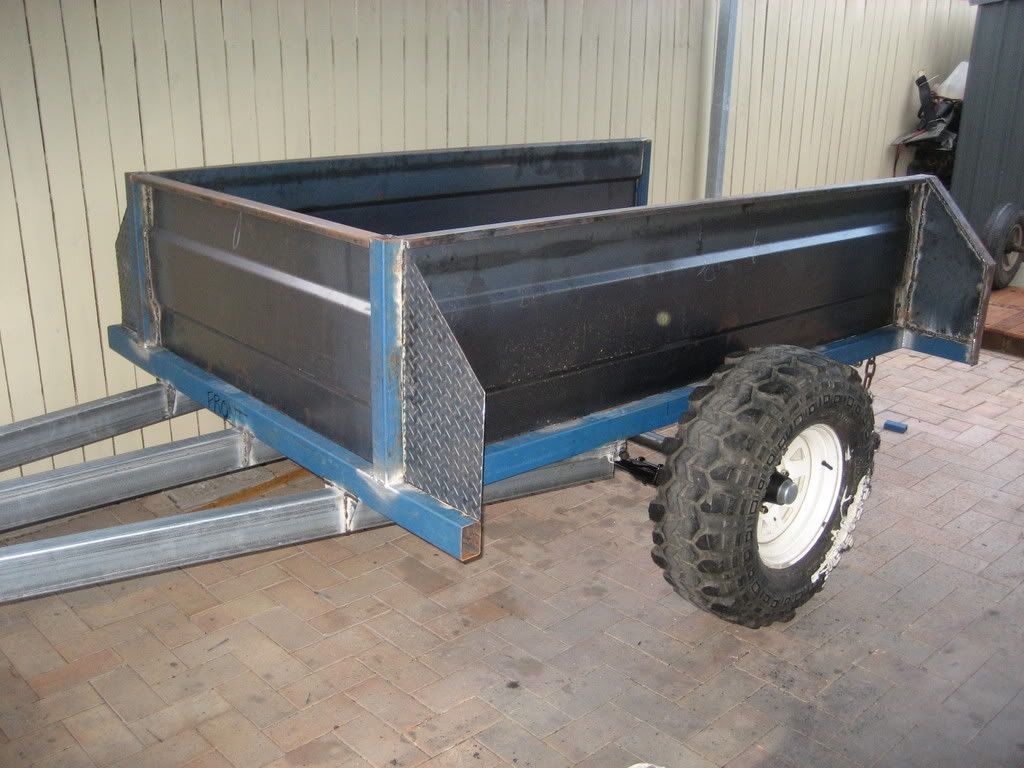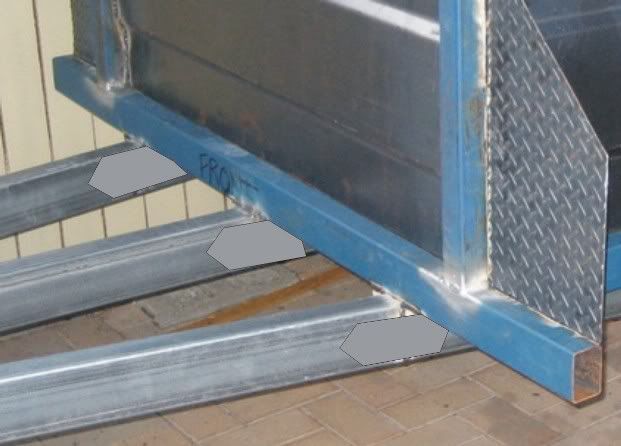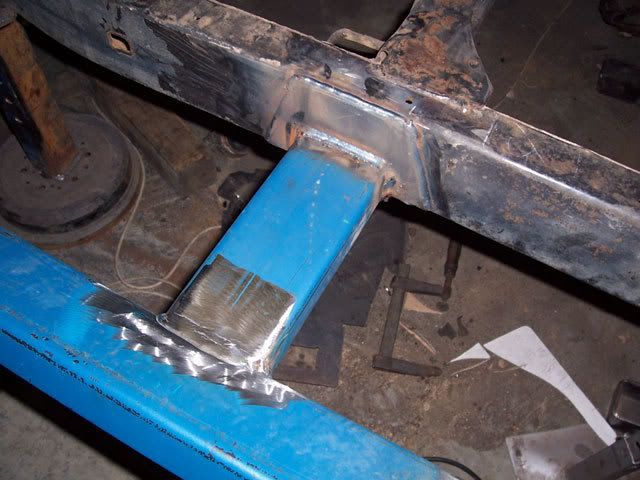Page 1 of 1
Fish Plates and reinforcing structural members
Posted: Thu May 31, 2007 9:29 am
by dieseldude
Ultimately, this question is in reference to an off-road camper trailer....
I have asked this question in my build up thread - but thought I'd have more chance of an appropriate answer here.
As a general engineering question for future reference:
In this instance (& with drawbars in general), is it best to stitch flatbar strapping underneath the drawbars where they cross the front cross member - or is it best to make fish plates welded onto the vertical side faces of the drawbars <==>? Would you make the strapping underneath tapered like this <==> also - or would normal square ends be fine as long as they weren't welded across the drawbar member?
Also, how long do you know to make these fish plates? How far either side of the stress points should the fish plates extend?
These queries are in relation to the following set up:

You can see that I have welded triangular gussets vertically on either side of the 3 drawbars. I have since realized that this is incorrect in that it causes stress points where you definitely don't want them. If I were to remove these (grind them off), would fishplates on the sides of the drawbars be the correct method to strengthen these members, or would fish plates welded underneath the drawbars be a better option?
I know that how I have this set up at present would probably be strong enough - but I plan on using this trailer for remote travel. As such, would rest easier knowing that I haven't left this major component to chance.
I look forward to your replies.
Anthony.
Posted: Thu May 31, 2007 10:12 am
by +dj_hansen+
Not being a structural engineer, but this is what i would be doing.
Fish plates on either vertical side of the draw bars, with some plate gussets like you already had.

The fish plates spread the load over a greater area, and the arrowed ends dont create a stress riser.
For ideas on fish plate size, to steal one of bubs pics:

Bubs has used IIRC 100 x 50 box section there, and id say the fish plate extends either side of the slider mount by a minmum of 50mm.
Like i said, im not an engineer, chassis welder, fabricator... but im bored and this beats doing my geology homework . Hope it helps dude.

Posted: Thu May 31, 2007 1:25 pm
by dieseldude
If I were to use diamond shaped fish plates, is there a rule which governs how thick to make them?
Given that the drawbars are 150 x 50 x 3mm RHS, should I allow for say 4mm plates on either side of the drawbar?
How long should these plates be made? 300mm long each? Would the plates extending 150mm either side of the stress point which I've introduced (by welding on those vertical gussets) be enough to rectify this?
Anthony.
Posted: Thu May 31, 2007 1:28 pm
by dieseldude
Should I use the same thickness (fish plates) as the drawbars so that the drawbars can still flex over their entire length?
After all, I'm just trying to get rid of the stress points which I mistakenly added, and restore the ability of the drawbars to flex if need be.
I'm not trying to make these draw bars indestructable and stop all movement.
Thanks.
Posted: Thu May 31, 2007 1:50 pm
by STIKA
why have you welded there?
Posted: Thu May 31, 2007 1:56 pm
by mavzilla
dont weld on the draw bar other than front to back on 2 sides of the chassis 2 draw bar leave other 2 sides unwelded< across ways> and it will be shit loads stonger<ps i would be gettin new unwelded stell but thats me>
Posted: Thu May 31, 2007 2:02 pm
by dieseldude
mavzilla wrote:dont weld on the draw bar other than front to back on 2 sides of the chassis 2 draw bar leave other 2 sides unwelded< across ways> and it will be shit loads stonger<ps i would be gettin new unwelded stell but thats me>
Mate, that's a mission to get new steel for these members...... a fair bit of work has gone into getting these set up and the hitch, chains etc etc.
I doubt that these drawbars will have strength issues, but would like to err on the side of caution and be sure.
I am aware that you don't weld across the drawbars - but my question relates to the gussets on the sides. Fair enough I should have put plates there first before adding this gussets, but now I need to rectify what I've done just to be sure.
My parents have just bought a new full off-road model caravan and it has a similar set up to mine on the drawbars (in terms of the vertical gussets), except on their trailer, they're welded to plates on the sides of the drawbars. These plates are then stitch welded along the top and bottom edges. Their trailer has apparently been around Australia and weighs 1600kgs and hasn't snapped.
I assume that if I were to plate the sides of my drawbars with 3mm diamond fish plates then this would be fine?
Please feel free to comment.
Posted: Thu May 31, 2007 2:14 pm
by STIKA
what are the gussets for
Posted: Thu May 31, 2007 2:26 pm
by dieseldude
They are for sideways strength because such a tall narrow drawbar is joined on the narrow edge. These are fine to add as long as they are welded to plates instead of directly to the drawbar sides themselves.
Posted: Thu May 31, 2007 2:39 pm
by STIKA
what are the deminsions of the trailer box
Posted: Thu May 31, 2007 2:43 pm
by dieseldude
Sorry for thinking out a loud here, but it makes me get ideas out and hopefully people with expertise in this department might comment.
Would adding a 200mm long strap to the bottom of each drawbar not add considerable strength to each of the members?
Surely this would add more steel to the bottom of the drawbars and allow for flex still.
Would fish plates welded to the sides of the drawbars brace them somewhat and stop them from being able to flex? I guess this could be compared to diagonal braces on a roll cage. They stop diagonal movement.......... hence flex?
This makes some sense to me. Have I explained it well enough for you guys to pass comment?
Anthony.
Posted: Thu May 31, 2007 2:51 pm
by dieseldude
STIKA wrote:what are the deminsions of the trailer box
The trailer is 7ft x 4ft with a 1900mm long drawbar.
Posted: Thu May 31, 2007 3:13 pm
by STIKA
From my limited experience the draw bar will be at it weakest point where you have welded. (you dont want any flex in the draw bar) This is where the trailer will flex and crack beside the weld.
my trailer is of similar deminsions and 10 years old and i have no gussets and have never had any problems.
So i would add fish plates as drawn above to get the load /flex away from the weld. i would make the fish plates out of 4 or 5mm plate on each side of the chasis rail and not worry about the gusets
as for strength under the draw bar i would use a piece of 10mm round bar and cut it about 300mm shorter than each draw bar rail
Center the bar on the underside of the drawbar rail
Weld 50 mm on each end of the flat bar
Cut 50 x 50 x 5mm flat bar -3 pieces
Find and mark the centre of the round bar
Prior the round bar and install the 50 x 50 under the bar so it is under tension
Weld the 50 x 50 to the draw bar and the round bar
Install the other 2, 50 x 50 spacers
With this bar under tennsion it will add considerable strength to the draw bar[/list]
Posted: Thu May 31, 2007 4:27 pm
by AdrianGQ
first question are your spring hangers welded directly to the rhs? If so i would be more concerned about them tearing the wall out of the rhs than your drawbar failing.
At work we build trailers that carry upto 4 ton and dont have any trouble with them we make the base frame of the trailer as you have done then we run angle iron down the full length on both sides of the trailer with one side of the angle underneath the box and the other running up the out side of it. In your case i would use 50x75x5mm or 4mm would do the job this is then stitch welded in place. You can then weld your spring hangers and drawbar to this. At the front where the drawbar is welded to the trailer put a plate 50x150mm same thickness as angle used between the drawbar and base frame and weld into place
Posted: Thu May 31, 2007 4:53 pm
by dieseldude
AdrianGQ wrote:first question are your spring hangers welded directly to the rhs? If so i would be more concerned about them tearing the wall out of the rhs than your drawbar failing.
At work we build trailers that carry upto 4 ton and dont have any trouble with them we make the base frame of the trailer as you have done then we run angle iron down the full length on both sides of the trailer with one side of the angle underneath the box and the other running up the out side of it. In your case i would use 50x75x5mm or 4mm would do the job this is then stitch welded in place. You can then weld your spring hangers and drawbar to this. At the front where the drawbar is welded to the trailer put a plate 50x150mm same thickness as angle used between the drawbar and base frame and weld into place
Do you have any images of this mate? I'm sure any pictures you have will make it much easier to visualize. Either that - or feel free to edit my pics to explain what you mean.
Regarding the spring hangers, you can see my write up in the build up section:
http://outerlimits4x4.com/viewtopic.php?t=106712
Keep in mind mate that this trailer will never be holding more than say 750kgs.

Surely building it too strong will equate to more weight and being too rigid could cause it to self destruct?
Too many variables I reckon.

I can't believe how much of a learning curve this is regarding building these things.....
I really appreciate everyone's input.
Keep it coming guys.
Posted: Thu May 31, 2007 5:59 pm
by AdrianGQ
read your build up thread now and dont think you will have any issues with the strength of the drawbar in current form and keep up the good work
Posted: Fri Jun 01, 2007 8:50 am
by dieseldude
Thanks for the replies guys.
Anthony
Posted: Fri Jun 01, 2007 12:27 pm
by benhl
Speak to Bubs - he has done plenty of chassis extending, strengthening etc and would be able to give you a "what works" picture - not sure if that would constitute a "whats engineerable" idea but would certainly help.
He has always done very strong mods to mine and other trucks he works on

Posted: Fri Jun 01, 2007 5:20 pm
by 90Mav
I would be inclined to plate the underneath of the bars, as that would put your reinforcing under tension (over bumps or with high tounge weight).
I dont see any reason to plate the sides (other than to strenghten the damage done by the gussets). And i dont think the gussets themselves would be of any benifit anyway.
square bar ends would be fine as you wouldn't weld the ends anyway.
I would use a piece about 400 long in 4 or 5 mm.
If you do decide to plate the sides, cut 45deg off each corner, leaving 1/3 of the flat end in the middle, and don't weld the 45's.
Hope this helps
Posted: Sat Jun 02, 2007 12:32 am
by nastytroll
the rhs you have used should be fine as is aslong as you have preped the joins n welded them properly, if the welds have good penitration n are ground flat to remove any fracture points should be fine. Also spring mounts will be fine as there is no flex on a trailer to fatigue the rhs, the chassis on the trailer you have built although not how I would have done it will proberly be stronger then the chassis of the vehicle towing it.
Take a trip to a professional trailer builders or shop n look at the crap they sell if you have any doubts, also consider the crap construction of most professional towbars used to pull heavy loads
Best O luck n have fun with the fab work.
Posted: Sat Jun 02, 2007 3:15 pm
by KiwiBacon
dieseldude wrote:They are for sideways strength because such a tall narrow drawbar is joined on the narrow edge. These are fine to add as long as they are welded to plates instead of directly to the drawbar sides themselves.
Your drawbar is triangulated. There is no real bending stress on those tubes, just tension in one and compression in the other when being pulled sideways.
The spar up the middle will do little under sideloading, but will help transfer weight from the main body to the coupling if the trailer is loaded that way.



